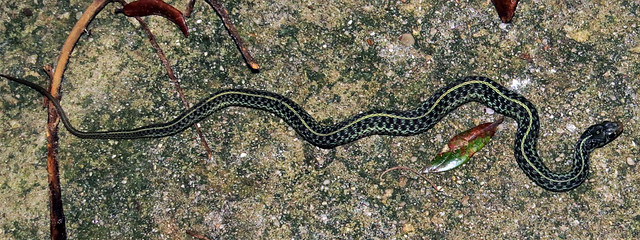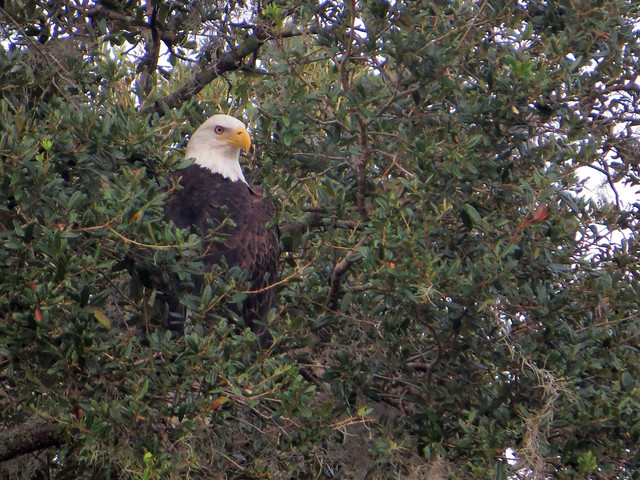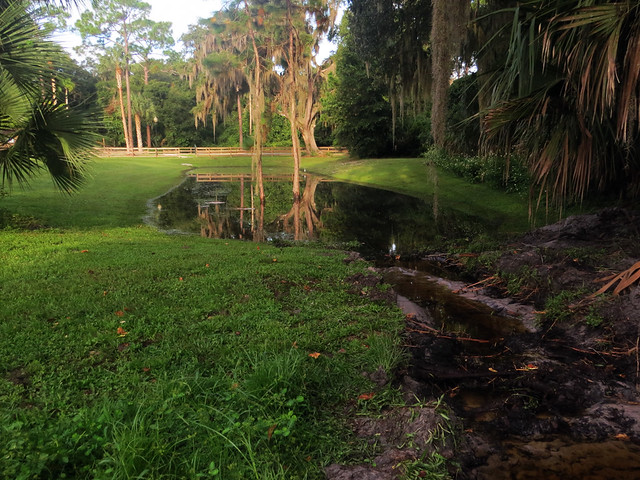In September I birded at Gemini Springs 21 times. I recorded 64 (+2 sp.) species of bird, a good increase over last year’s 56 species. The complete list is at the end of this post.
Clapper Rail was new to my park list; I heard at least one individual calling during much of the second half of the month. Also new to my all-time park list: Rock Pigeon (flyover flock); Peregrine Falcon (a thrilling fly-over); Common Nighthawk; Yellow-throated Vireo; and Purple Martin (a small flock; rather late). Those last two are kind of overdue as they’re not all that rare and have been recorded by others in the park. Gray Catbirds arrived right on time at the very end of the month.
There was a lot of rain during the month. The bayou / spring runs were higher than I’ve ever seen them and there were a lot of paths that were completely flooded. The sinkhole area flooded over until a small ditch was dug to a retention area — but then the entire area flooded over again a couple of days later. All the extra standing water gave mosquitoes extra breeding grounds; late in the month mosquitoes were the most annoying I’ve ever noticed at the park.
Here are some photo highlights from a month of birding at Gemini Springs.

Great Blue Heron | 01 September 2014

Golden Silk Orb-weaver sp. | 01 September 2014

Limpkin | 01 September 2014
During my walk on September 5th, I saw a few of these guys:

Air Potato Leaf Beetle | 05 September 2014
Apparently Air Potato Leaf Beetles were brought in to combat the Air Potato problem at the park. Without really knowing too much about this problem, the idea of bringing in non-native beetles to consume non-native plants makes me uneasy. I need to learn more about this procedure. Anyway, the beetles got busy on the air potatoes.

Air Potato leaves | 05 September 2014

Air Potato leaves | 05 September 2014

Barred Owl | 05 September 2014
This time of year, the seeds of the Magnolia trees at the park are ripening. And all around the park I could hear squirrels eating the seeds. Squirrels chewing with their mouths open sound like rocks being rubbed on metal files.

Magnolia tree seeds | 05 September 2014
This squirrel looked a bit rough, perhaps with a bot fly infestation. Bot flies are annoying to squirrels but most are not permanently debilitated by the flies.

Eastern Gray Squirrel, possibly with bot flies | 05 September 2014
I also found a very large snake skin on September 5th.

snake skin | 05 September 2014
I wanted to pull it out to take a picture of its full size, but it was so damp out I was afraid the skin would disintegrate when I touched it. It was surprisingly thick and durable; it felt like a bike inner tube! And it was kind of scary big.

snake skin detail | 05 September 2014

snake skin all stretched out | 05 September 2014

flooding around the sinkhole | 08 September 2014

high water in the spring run | 08 September 2014

Blue-striped Garter Snake | 10 September 2014

tadpole in sinkhole flood area | 13 September 2014

Eastern Gray Squirrel | 13 September 2014

Ovenbird | 15 September 2014

Bald Eagle watching over the spring run | 16 September 2014

Green Heron on the fishing pier | 16 September 2014

Young Little Blue Heron hunting in the sinkhole floodage | 20 September 2014

Red-shouldered Hawks — can you tell the male from the female? | 21 September 2014

White Ibis | 21 September 2014
On the 21st I had a very nice outing. I saw 36 species, including my first Common Ground-Dove in several months, a juvenile Loggerhead Shrike, my first Purple Martins at the park, a raucous family of Northern Mockingbirds that was fun to watch, a good number of warblers, etc etc. It was a good morning. When I got back to my bike I saw a lanky tortie cat hanging out by the bike rack. I made kissy noises, not really expecting the cat to approach me, but she did. Two of her kittens followed her, and eventually I got the two youngsters in my hands. But now what? The mother cat came and went, soliciting pets and purring loudly. I figured I would be able to catch her up eventually, but first I needed some help. I asked passersby for a box, but had no luck. Eventually a chap from the park came over and brought me a box. The kittens promptly escaped. As they made their escape, a third kitten appeared. Oh boy. The park chap brought over some cat food and eventually I caught the two kittens again, along with their sibling. I got ma cat too, but she went ballistic when I tried to put her in the box. I finally got in touch with my family and they arrived with a cat carrier for ma cat. They’ve all checked out healthy at the vet and have had their first round of shots. The two orange ones are boys; the black kitten is a girl. They don’t have names yet.

Cats! | 21 September 2014

Flood relief — ditch dug between sinkhole and retention area | 24 September 2014
On the 27th my mom and I attended a bird walk at the park sponsored by Lyonia Preserve and West Volusia Audubon. I rarely see other birders at the park so it was nice to see a bunch of them at the same time. We had a late start time (10AM!) and didn’t see a huge amount of birds, but it was a nice morning nonetheless.

Birders! | 27 September 2014

even higher water in the spring run | 27 September 2014

Little Blue Heron checking out the sinkhole and adjacent retention area — both completely flooded | 29 September 2014
See? I told you I’d have more photos for September than I had for August.
If you are a fan of Gemini Springs, please consider becoming a Fan of Gemini Springs on Facebook!

September 2014 bird list, Gemini Springs
Wood Duck – Aix sponsa
Double-crested Cormorant – Phalacrocorax auritus
Anhinga – Anhinga anhinga
Great Blue Heron – Ardea herodias
Great Egret – Ardea alba
Snowy Egret – Egretta thula
Little Blue Heron – Egretta caerulea
Tricolored Heron – Egretta tricolor
Cattle Egret – Bubulcus ibis
white egret sp. – Egretta/Bubulcus sp.
Green Heron – Butorides virescens
White Ibis – Eudocimus albus
Black Vulture – Coragyps atratus
Osprey – Pandion haliaetus
Bald Eagle – Haliaeetus leucocephalus
Red-shouldered Hawk – Buteo lineatus
Clapper Rail – Rallus crepitans
Common Gallinule – Gallinula galeata
American Coot – Fulica americana
Limpkin – Aramus guarauna
Sandhill Crane – Grus canadensis
Spotted Sandpiper – Actitis macularius
Rock Pigeon – Columba livia
Common Ground-Dove – Columbina passerina
Mourning Dove – Zenaida macroura
Barred Owl – Strix varia
Common Nighthawk – Chordeiles minor
Chimney Swift – Chaetura pelagica
Belted Kingfisher – Megaceryle alcyon
Red-bellied Woodpecker – Melanerpes carolinus
Downy Woodpecker – Picoides pubescens
Northern Flicker – Colaptes auratus
Pileated Woodpecker – Dryocopus pileatus
Peregrine Falcon – Falco peregrinus
Empidonax sp. – Empidonax sp.
Great Crested Flycatcher – Myiarchus crinitus
Eastern Kingbird – Tyrannus tyrannus
Loggerhead Shrike – Lanius ludovicianus
White-eyed Vireo – Vireo griseus
Yellow-throated Vireo – Vireo flavifrons
Red-eyed Vireo – Vireo olivaceus
Blue Jay – Cyanocitta cristata
American Crow – Corvus brachyrhynchos
Fish Crow – Corvus ossifragus
Purple Martin – Progne subis
Barn Swallow – Hirundo rustica
Carolina Chickadee – Poecile carolinensis
Tufted Titmouse – Baeolophus bicolor
Carolina Wren – Thryothorus ludovicianus
Blue-gray Gnatcatcher – Polioptila caerulea
Gray Catbird – Dumetella carolinensis
Brown Thrasher – Toxostoma rufum
Northern Mockingbird – Mimus polyglottos
Ovenbird – Seiurus aurocapilla
Black-and-white Warbler – Mniotilta varia
Common Yellowthroat – Geothlypis trichas
American Redstart – Setophaga ruticilla
Northern Parula – Setophaga americana
Yellow Warbler – Setophaga petechia
Black-throated Blue Warbler – Setophaga caerulescens
Yellow-throated Warbler – Setophaga dominica
Prairie Warbler – Setophaga discolor
Northern Cardinal – Cardinalis cardinalis
Red-winged Blackbird – Agelaius phoeniceus
Common Grackle – Quiscalus quiscula
Boat-tailed Grackle – Quiscalus major





2 Responses to Birding Gemini Springs, September 2014